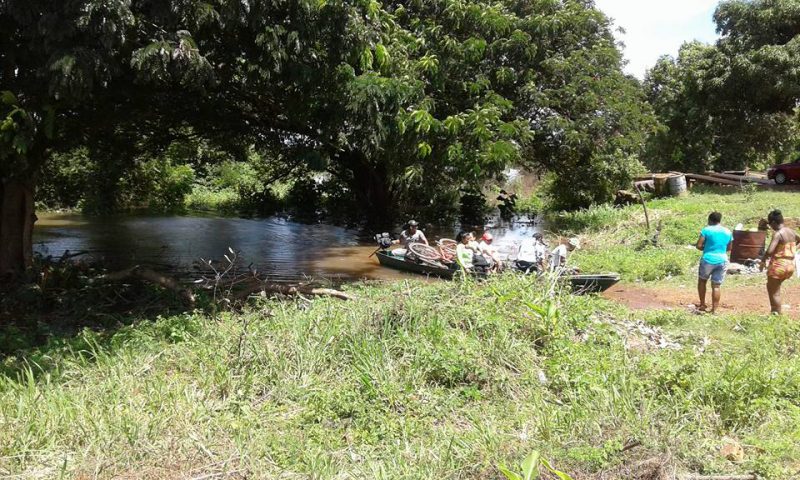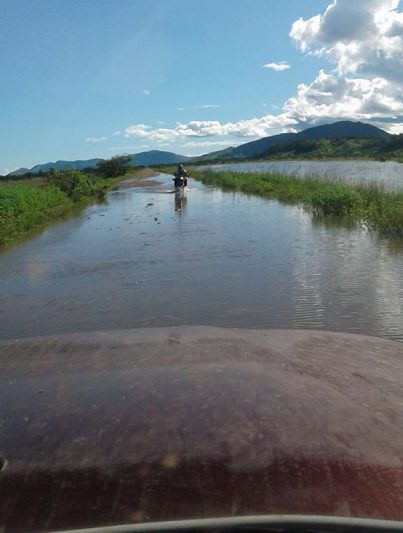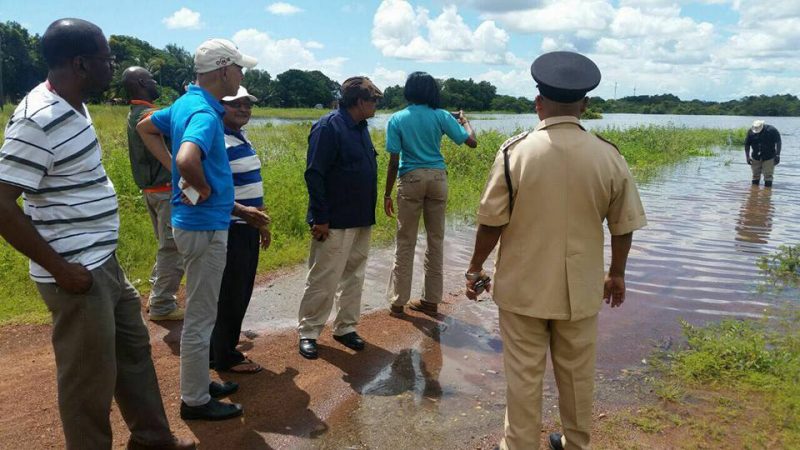Flooding due to heavy rainfall and the cresting of rivers in Region Nine has left dozens of farms across the South Rupununi inundated, while cutting off crucial movement between communities.
Deputy Director General of the Civil Defence Commission (CDC) Major Kester Craig, in an invited comment, told Stabroek News that the CDC is working alongside the Regional Democratic Council (RDC) to address the situation after several days of continuous rainfall left several villages flooded, resulting in their evacuation.
Craig was one of several officials who accompanied Prime Minister Moses Nagamootoo and Minister of Communities Ronald Bulkan on an emergency visit to the region yesterday to assess the extent of the situation and meet with regional officials. “We have communities in North Rupununi, South Rupununi and Central Rupununi that are affected; we have cases where the farmlands are affected, cases where only residential areas are affected and in other cases there is a combination of both,” he related.
This, he said, has prompted the activation of the Regional Emergency Operation Centre, headed by the Regional Chairman, to give updates on the situation. Additionally, they have opened three shelters at the Arapaima Primary School, the Amerindian Hostel and the Culvert City Nursery School. Hotlines have also been established to allow residents to call, in the event that they need to be relocated.
According to Craig, initial assessments indicate that the Central Rupununi is the most affected, particularly those areas closer to the Takutu. However, most persons would have already evacuated the area and have opted to stay with relatives rather than utilise the established shelters.
In the meantime, the CDC has sent up a number of supplies, including sanitation items to be distributed to the most affected people in the region.
“We will continue to monitor the situation and lend our support to the region; we have deployed our Preparedness Response Manager to give support to the RDC in terms of operational support and they are also doing a further assessment to get a better understanding of what is happening at the other remote location because some of them the water is very high and it is difficult to get to those locations, “Craig explained.
“We are presently waiting on the Toshaos to send in information to us, so we can get a better understanding of what is going on in those areas and the total number of persons affected; at this time we do not have all that information because Region Nine is big and vast compared to the other regions, so we are waiting for more details to compile a more comprehensive report,” he added.
Nonetheless, recommendations have reportedly been made to have schools in areas, such as Karasabai in the South Pakaraimas, closed off for the rest of the week out of concern for children who would be exposed to harmful vectors.
‘Cut off’
Meanwhile, in some places, such as Awaruwaunau Village in the Deep South, reports are that they have experienced heavy rainfall almost every night for the past two weeks, resulting in an estimated 35 farms being completely covered by water.
Toshao of the village Jenny Thomas, who spoke to Stabroek News last evening, said the waters have risen to a point where the village has been cut off from both the North Rupununi and Lethem.
“We had rains almost every night for the past 10 days and the water in the Rupununi continues to rise, cutting us off from North Rupununi and no we cannot even go into Lethem because the roads are covered. There are persons trying to cross the river with canoes but that in itself is very risky because the water is very, very high,” Thomas related.
“We are really trying with the farms though… this week alone, I have received reports from at least 35 farmers about their farms being flooded… crops like corn, potatoes and cassava have been damaged and the rains continue to fall; I can only imagine what will happen to us next week if it continues like this,” the woman added.
Similar sentiments were shared by Deputy Toshao of Aishalton Village Dorothy James, who was assessing the extent of the damage done to her farm as she spoke to Stabroek News.
“We have had excessive rainfall for the past two weeks and a lot of our farms are soaked right now. So we are here, right now, seeing how much of our cassava can be saved because our farmlands are covered and a lot of cassava is underwater right now,” she related.
James also shared details of an incident where a female resident almost drowned yesterday morning after the canoe the woman was travelling in capsized as she and a male companion made their way to a nearby bridge. Though there is a road leading to the bridge, the floodwaters have since covered the road, forcing those who are brave enough to make the journey across via canoe.
“The woman and the man were trying to transport a motorcycle to the bridge in a small canoe, when, I guess, the strong currents caused the boat to capsize… thankfully, someone was able to save the woman, who was unconscious…,” James related, before lamenting the fact that the motorcycle went down and had not been recovered.
The covered roads have also resulted in several vehicles being “stalled up” on one side of the bridge as they are unable to manoeuvre the road.
Resident and former Toshao of Aishalton Tony James, who also spoke to Stabroek News, yesterday said he is concerned about the restricted movement of residents between Aishalton and Lethem, since this would hinder the sourcing of other supplies to the community.
“There is no movement between Aishalton and Lethem, right now, which is going to impact us heavily, since we won’t be able to travel and purchase our usual commodities and it is going to be harder for us now since our farms are under water,” James shared.
‘Still coming up’
David (only name given), a resident of Mango Grove, Lethem, explained that his yard and his neighbours’ yard are completely flooded. He noted that though the current situation is not as bad as the one in 2011, those who reside in Mango Grove have already started preparing for the worst.
And though there has been no rainfall over the last two days in that area, water has not started to recede, instead it continues to rise.
This has led David to believe that it is the water that is flowing from the neighbouring Rio Branco River in Brazil into the Takutu and Ireng Rivers that is causing the rivers here to overtop its banks, ultimately preventing the water from draining off the land.
“It’s mostly the roads covered, right, but the water is still coming up and we are just trying to prepare in the event that the situation worsens. We are ready to move if it comes to that. If the water starts to rise though, our only hope is that it happens in the day and not in the night since we would not be caught off guard like we had been in 2011,” David said.
He further related that though several attempts have been made to contact persons in Sand Creek, which is situated in a valley, he was up to last evening unable to ascertain what the situation there was.
In other parts of Lethem, reports are that as of yesterday midday the water had risen by an estimated 6 inches over the previous 11 hours; boats were also being used to shuttle residents to St Ignatius Village in the South/Central Rupununi District.
Regional Chairman Bryan Allicock on Sunday had told Stabroek News that rain had blanketed the Rupununi for the past week and more was expected based on weather forecasts.
He had also related that the RDC was able to relocate 26 persons to the established shelters on Sunday. However, attempts to contact him yesterday for an update on the situation in the region were unsuccessful.













